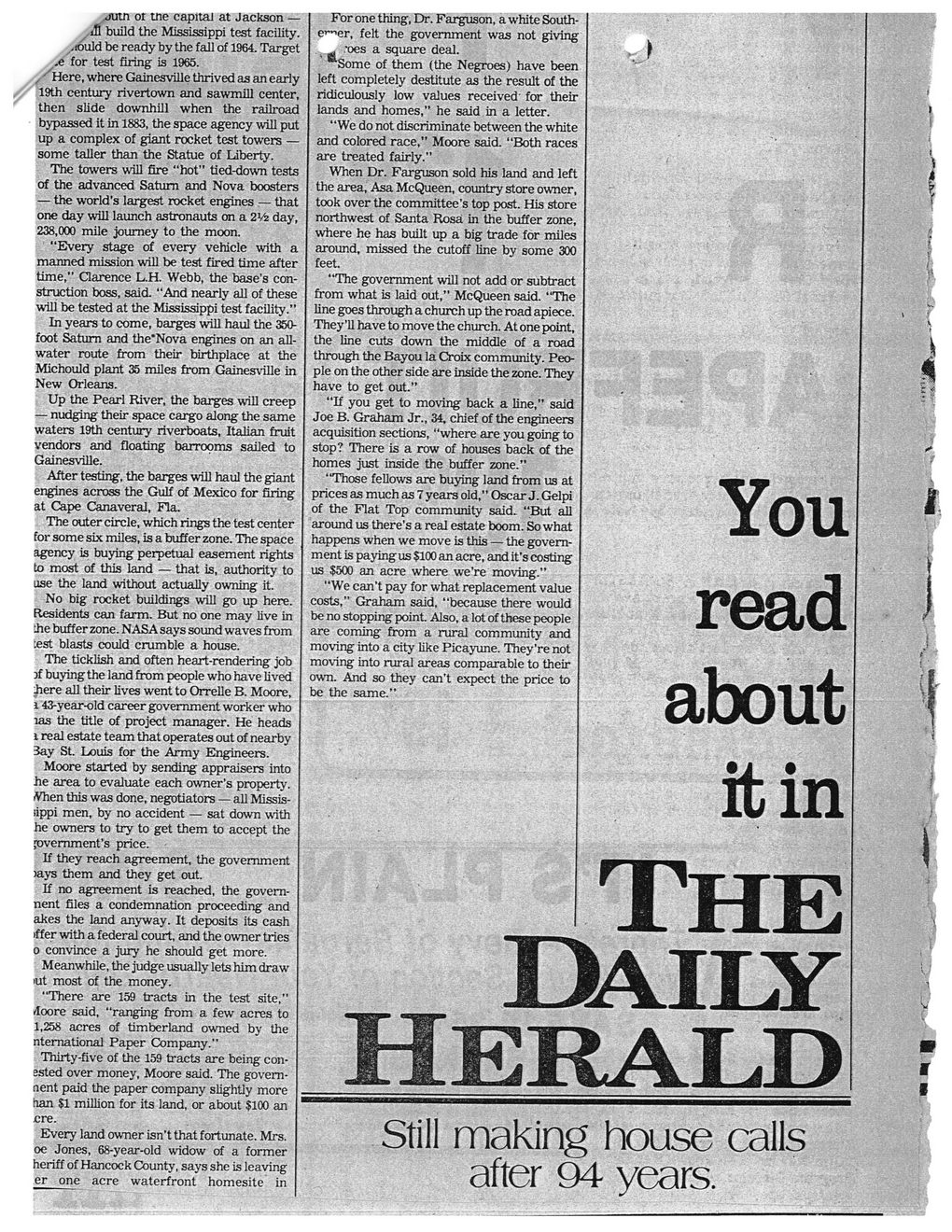This text was obtained via automated optical character recognition.
It has not been edited and may therefore contain several errors.
,jutn ot tne capital at Jackson — ifi build the Mississippi test facility, xiould be ready by the fall of 1964. Target .e for test firing is 1965. , ^Here, where Gainesville thrived as an early 19th century rivertown and sawmill center, then slide downhill when the railroad bypassed it in 1883, the space agency will put up a complex of giant rocket test towers — some taller than the Statue of Liberty. The towers will fire “hot” tied-down tests of the advanced Saturn and Nova boosters — the world's largest rocket engines — that one day will launch astronauts on a 2Vi day, 238,000 mile journey to the moon. “Every stage of every vehicle with a manned mission will be test fired time after time,” Clarence L.H. Webb, the base’s construction boss, said. “And nearly all of these will be tested at the Mississippi test facility.” In years to come, barges will haul the 350-foot Saturn and the'Nova engines on an allwater route from their birthplace at the Michould plant 35 miles from Gainesville in New Orleans. Up the Pearl River, the barges will creep — nudging their space cargo along the same waters 19th century riverboats, Italian fruit vendors and floating barrooms sailed to Gainesville. After testing, the barges will haul the giant engines across the Gulf of Mexico for firing at Cape Canaveral, Fla. The outer circle, which rings the test center for some six miles, is a buffer zone. The space agency is buying perpetual easement rights to meat of this land — that is, authority to use the land without actually owning it. No big rocket buildings will go up here. Residents can farm. But no one may live in ihe buffer zone. NASA says sound waves from :est blasts could crumble a house. The ticklish and often heart-rendering job )f buying the land from people who have lived here all their lives went to Orrelle B. Moore, 143-year-old career government worker who las the title of project manager. He heads i real estate team that operates out of nearby 3ay St. Louis for the Army Engineers. Moore started by sending appraisers into he area to evaluate each owner’s property. iVhen this was done, negotiators — all Mississippi men, by no accident — sat down with he owners to try to get them to accept the government’s price. If they reach agreement, the government >ays them and they get out. If no agreement is reached, the govem-nent files a condemnation proceeding and akes the land anyway. It deposits its cash iffer with a federal court, and the owner tries o convince a jury he should get more. Meanwhile, the judge usually lets him draw iut most of the money. “There are 159 tracts in the test site,” rtoore said, “ranging from a few acres to 1,258 acres of timberland owned by the ntemational Paper Company." Thirty-five of the 159 tracts are being conested over money, Moore said. The govem-nent paid the paper company slightly more han $1 million for its land, or about $100 an ere. Every land owner isn’t that fortunate. Mrs. oe Jones, 68-year-old widow of a former heriff of Hancock County, says she is leaving er one acre waterfront homesite in For one thing, Dr. Farguson, a white South-e^er, felt the government was not giving t — 'oes a square deal. Some of them (the Negroes) have been left completely destitute as the result of the ridiculously low values received for their lands and homes,” he said in a letter. “We do not discriminate between the white and colored race,” Moore said. “Both races are treated fairly." When Dr. Farguson sold his land and left the area, Asa McQueen, country store owner, took over the committee’s top post. His store northwest of Santa Rosa in the buffer zone, where he has built up a big trade for miles around, missed the cutoff line by some 300 feet. "The government will not add or subtract from what is laid out,” McQueen said. “The line goes through a church up the road apiece. They’ll have to move the church. At one point, the line cuts down the middle of a road through the Bayou la Croix community. People on the other side are inside the zone. They have to get out.” “If you get to moving back a line,” said Joe B. Graham Jr., 34, chief of the engineers acquisition sections, “where are you going to stop? There is a row of houses back of the homes just inside the buffer zone.” “Those fellows are buying land from us at prices as much as 7 years old,” Oscar J. Gelpi of the Flat Top community said. “But all around us there’s a real estate boom. So what happens when we move is this — the government is paying us $100 an acre, and it’s costing us $500 an acre where we’re moving.” “We can’t pay for what replacement value costs,” Graham said, "because there would be no stopping point. Also, a lot of these people are coming from a rural community and moving into a city like Picayune. They’re not moving into rural areas comparable to their own. And so they can’t expect the price to be the same.” You read about itin The Daily ERALD Still making house calls after 94 years.

NASA NASA-Daily-Herald2